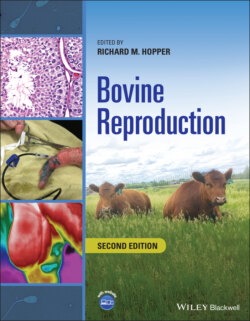Читать книгу Bovine Reproduction - Группа авторов - Страница 220
Incomplete Separation of the Penile and Preputial Epithelium
ОглавлениеPrior to puberty, the epithelium of the free portion of the juvenile penis and the integumentary epithelium of the penile portion of internal lamina of the prepuce are joined by an interdigitating attachment [7–9]. Exposure to the trophic effects of androgens as bulls approach puberty leads to an increase in penile size and to development of the sigmoid flexure characteristic of ruminants. Simultaneous with the increase in penile size, the epithelial attachments between the preputial skin and the epithelial surface of the free portion of the penis weaken and begin separating. Separation may be facilitated by mounting activity and early attempts at erection during sexual role playing by young bulls. Until the separation is complete at 8–11 months of age, extension of the penis is not possible [7, 8, 10].
Normal separation is sometimes delayed and may result in an inability to fully extend the penis at the time of a breeding soundness examination or during an observed breeding attempt (Figure 15.1a). The attachment will often spontaneously regress in affected bulls if allowed adequate time to mature, but assisted separation by gentle application of manual traction to the penis is sometimes advocated in cases where partial separation has already occurred (Figure 15.1b and c).
Figure 15.1 (a) Failure of separation of the epithelium of the free portion of the penis and the penile portion of the prepuce. (b) Note the adherence between the preputial and penile skin. Application of gentle traction to the penis to facilitate adherence breakdown. (c) Penile and preputial epithelium following breakdown of the epithelial adherence.
Source: Courtesy of Robert L. Carson and Dwight Wolfe.
Young bulls at times tear the epithelial attachment prematurely, and hemorrhage into the space between the penile and preputial epithelium results in a localized hematoma. Such injuries may go unnoticed and are often self‐limiting [10]. If bacteria gain access to the damaged tissues and associated hematoma, abscess formation and fibrosis may compromise the ability to extend the penis. Case management should emphasize isolation from other animals to discourage sexual role‐playing during the healing period, accompanied by broad‐spectrum antibiotic treatment to minimize complications. Drainage of an abscess in this location is difficult and must be done with care to minimize loss of the elastic layers of the prepuce.
